Influence of Different Ambient Temperatures on the Thermal Properties of Fiber-Reinforced Structural Lightweight Aggregate Concrete
Abstract
:1. Introduction
2. Materials and Methods
2.1. Materials
2.2. Mix Design and Mixing Procedure
2.3. Experimental Procedure
- i.
- Two thicknesses of 10 mm and 20 mm of the disc samples are run. The 10 mm thickness is to minimize lateral heat loss and the 20 mm thickness to allow the maximum 12 mm LECA aggregate size effect. The average value is taken from the two thicknesses.
- ii.
- The parallelism of the sample surfaces is of importance with less than a 1% gradient, which is less than the +0.55 mm thickness variation at the opposite ends.
- iii.
- Reject surfaces with macro-voids and repair any surfaces with micro-pores.
- iv.
- Surfaces are grinded and polished to P800 sanding to provide good surface contacts.
- v.
- Rubber sheets are used to minimize the air gap between the two isothermal plates and the surfaces of the sample.
- vi.
- An average of 6 running samples are run to get the mean values and their COVs.
3. Results and Discussion
3.1. Physical and Mechanical Properties
3.2. Influence of the Ambient Temperature on the Thermal Properties of Fibre-Reinforced LWAC
3.2.1. Thermal Conductivity
3.2.2. Specific Heat
3.2.3. Thermal Diffusivity
3.2.4. Thermal Effusivity
4. Conclusions
- The ST and PP fiber LWAC have a thermal conductivity ranging from 1.185–1.4415 W/mK and 0.9762–1.1377 W/mK, respectively, when the ambient temperature is within 0 °C to 50 °C. In terms of fiber category, the ST fiber LWAC had a higher conductivity than PP fiber and plain LWAC.
- The ST and PP fiber LWAC have a specific heat ranging 791–967 J/kgK and 833–980 J/kgK, respectively, when the ambient temperature is within 0 °C to 50 °C. In terms of fiber category, the ST fiber concrete had a higher specific heat than PP fiber LWAC.
- The ST and PP fiber LWAC have a thermal diffusivity ranging from 0.687–0.916 mm2/s and 0.620–0.772 mm2/s, respectively, when the ambient temperature is within 0 °C to 50 °C. The ST fiber concrete had a higher diffusivity than PP fiber LWAC.
- The ST and PP fibers LWAC have a thermal effusivity ranging from 1349–1580 J/Km2s1/2 and 1171–1335 J/Km2s1/2, respectively, when the ambient temperature is within 0 °C to 50 °C. The ST fiber concrete had a higher effusivity than PP fiber concrete.
- The temperature-dependent thermal conductivity and thermal diffusivity decreased linearly between 0 °C and 50 °C with a very strong linear correlation.
- The temperature-dependent specific heat and thermal effusivity increased linearly between 0 °C and 50 °C with a very strong linear correlation.
- The equations to predict thermal conductivity, specific heat, thermal diffusivity, and thermal effusivity as a function of the ambient temperature, ranging from 0 °C to 50 °C, were proposed.
Author Contributions
Funding
Institutional Review Board Statement
Informed Consent Statement
Data Availability Statement
Acknowledgments
Conflicts of Interest
References
- Manioğlu, C.; Yılmaz, Z. Energy efficient design strategies in the hot dry area of Turkey. Build. Environ. 2008, 43, 1301–1309. [Google Scholar] [CrossRef]
- Real, S.; Gomes, M.G.; Rodrigues, A.M.; Bogas, J.A. Contribution of structural lightweight aggregate concrete to the reduction of thermal bridging effect in buildings. Constr. Build. Mater. 2016, 121, 460–470. [Google Scholar] [CrossRef]
- Asadi, I.; Shafigh, P.; Abu Hassan, Z.F.B.; Mahyuddin, N.B. Thermal conductivity of concrete—A review. J. Build. Eng. 2018, 20, 81–93. [Google Scholar] [CrossRef]
- Campione, G.; Miraglia, N.; Papia, M. Mechanical properties of steel fibre reinforced lightweight concrete with pumice stone or expanded clay aggregates. Mater. Struct. Mater. Constr. 2001, 34, 201–210. [Google Scholar] [CrossRef]
- Hassanpour, M.; Shafigh, P.; Bin Mahmud, H. Lightweight aggregate concrete fibre reinforcement—A review. Constr. Build. Mater. 2012, 37, 452–461. [Google Scholar] [CrossRef]
- Real, S.; Bogas, J.A.; Glória, G.M.; Ferrer, B. Thermal conductivity of structural lightweight aggregate concrete. Mag. Concr. Res. 2016, 15, 798–808. [Google Scholar] [CrossRef]
- Ma, P.; Wang, L.S. Effective heat capacity of interior planar thermal mass (iPTM) subject to periodic heating and cooling. Energy Build. 2012, 27, 44–52. [Google Scholar] [CrossRef]
- Gül, R.; Okuyucu, E.; Türkmen, I.; Aydın, A.C. Thermo-mechanical properties of fibre reinforced raw perlıte concrete. Mater. Lett. 2007, 29, 5145–5149. [Google Scholar] [CrossRef]
- Grabois, T.M.; Cordeiro, G.C.; Filho, R.D.T. Fresh and hardened-state properties of self-compacting lightweight concrete reinforced with steel fibre. Constr. Build. Mater. 2016, 104, 284–292. [Google Scholar] [CrossRef]
- Nagy, B.; Nehme, S.G.; Szagri, D. Thermal properties and modeling of fibre-reinforced concretes. Energy Procedia 2015, 78, 2742–2747. [Google Scholar] [CrossRef] [Green Version]
- Nguyen, L.H.; Beaucour, A.L.; Ortola, S.; Noumowé, A. Experimental study on the thermal properties of lightweight aggregate concretes at different moisture contents and ambient temperatures. Constr. Build. Mater. 2017, 151, 720–731. [Google Scholar] [CrossRef]
- Kim, K.H.; Jeon, S.E.; Kim, J.K.; Yang, S. An experimental study on thermal conductivity of concrete. Cem. Concr. Res. 2003, 33, 363–371. [Google Scholar] [CrossRef]
- Nguyen, L.H.; Beaucour, A.L.; Ortola, S.; Noumowé, A. Influence of the volume fraction and the nature of fine lightweight aggregates on the thermal and mechanical properties of structural concrete. Constr. Build. Mater. 2014, 51, 121–132. [Google Scholar] [CrossRef]
- Tasdemir, C.; Sengul, O.; Tasdemir, M.A. A comparative study on the thermal conductivities and mechanical properties of lightweight concretes. Energy Build. 2017, 151, 469–475. [Google Scholar] [CrossRef]
- Wang, W.C.; Wang, H.Y.; Chang, K.H.; Wang, S.Y. Effect of high temperature on the strength and thermal conductivity of glass fibre concrete. Constr. Build. Mater. 2020, 245, 118–387. [Google Scholar] [CrossRef]
- Wang, W.; Lu, C.; Li, Y.; Li, Q. An investigation on thermal conductivity of fly ash concrete after elevated temperature exposure. Constr. Build. Mater. 2017, 148, 148–154. [Google Scholar] [CrossRef]
- Al-Sibahy, A.; Edwards, R. Thermal behaviour of novel lightweight concrete at ambient and elevated temperatures: Experimental, modelling and parametric studies. Constr. Build. Mater. 2012, 31, 174–187. [Google Scholar] [CrossRef]
- Kizilkanat, A.B.; Yuzer, N.; Kabay, N. Thermo-physical properties of concrete exposed to high temperature. Constr. Build. Mater. 2013, 45, 157–161. [Google Scholar] [CrossRef]
- Shin, K.Y.; Kim, S.B.; Kim, J.H.; Chung, M.; Jung, P.S. Thermo-physical properties and transient heat transfer of concrete at elevated temperatures. Nucl. Eng. Des. 2002, 22, 233–241. [Google Scholar] [CrossRef] [Green Version]
- Othman, M.A.; Wang, Y.C. Elevated-temperature thermal properties of lightweight foamed concrete. Constr. Build. Mater. 2011, 25, 705–716. [Google Scholar] [CrossRef]
- Pliya, P.; Beaucour, A.L.; Noumowé, A. Contribution of cocktail of polypropylene and steel fibre in improving the behaviour of high strength concrete subjected to high temperature. Constr. Build. Mater. 2011, 25, 1926–1934. [Google Scholar] [CrossRef]
- Morabito, P. Measurement of the thermal properties of different concretes. High Temp. High Press. 1989, 21, 51–59. [Google Scholar]
- Khaliq, W.; Kodur, V. Thermal and mechanical properties of fibre reinforced high performance self-consolidating concrete at elevated temperatures. Cem. Concr. Res. 2011, 41, 1112–1122. [Google Scholar] [CrossRef]
- ASTM C567/C567M-19; Standard Test Method for Determining Density of Structural Lightweight Concrete. ASTM International: West Conshohocken, PA, USA, 2019.
- BS EN 12350-2:2009; Testing Fresh Concrete. Slump-Test. BSI: London, UK, 2009.
- BS EN 12350-3:2009; Testing Fresh Concrete. Vebe Test. BSI: London, UK, 2009.
- BS EN 12390-4:2009; Compressive Strength of Test Specimens. BSI: London, UK, 2009.
- ASTM C518-98; Standard Test Method for Steady-State Thermal Transmission Properties by Means of Heat Flow Meter Apparatus. ASTM International: West Conshohocken, PA, USA, 1998.
- ASTM C1784-14; Standard Test Method for Using a Heat Flow Meter Apparatus for Measuring Thermal Storage Properties of Phase Change Materials and Products. ASTM International: West Conshohocken, PA, USA, 2014.
- Fraternali, F.; Ciancia, V.; Chechile, R.; Rizzano, G.; Feo, L.; Incarnato, L. Experimental study of the thermo-mechanical properties of recycled PET fibre-reinforced concrete. Compos. Struct. 2011, 93, 2368–2374. [Google Scholar] [CrossRef]
- Valcuende, M.; Lliso-Ferrando, J.R.; Roig-Flores, M.; Gandía-Romero, J.M. Porous Structure of Ultra-High-Performance Fibre-Reinforced Concretes. Materials 2021, 14, 1637. [Google Scholar] [CrossRef]
- Lamond, J.F.; Pielert, J.H. Significance of Tests and Properties of Concrete and Concrete-Making Materials; ASTM International Press: West Conshohocken, PA, USA, 2006. [Google Scholar]
- Mehta, P.K.; Monterio, P.J.M. Concrete: Microstructure, Properties and Materials; McGraw Hill Inc.: East Windsor, NJ, USA, 2006. [Google Scholar]
- ACI 213R-03; Guide for Structural Lightweight-Aggregate Concrete. American Concrete Institute: Farmington Hills, MI, USA, 2003.
- Yap, S.P.; Alengaram, U.J.; Jumaat, M.Z. Enhancement of mechanical properties in polypropylene- and nylon-fibre reinforced oil palm shell concrete. Mater. Des. 2013, 49, 1034–1041. [Google Scholar] [CrossRef]
- Li, J.; Niu, J.; Wan, C.; Liu, X.; Jin, Z. Comparison of flexural property between high performance polypropylene fibre reinforced lightweight aggregate concrete and steel fibre reinforced lightweight aggregate concrete. Constr. Build. Mater. 2017, 157, 729–736. [Google Scholar] [CrossRef]
- Choi, J.; Zi, G.; Hino, S.; Yamaguchi, K.; Kim, S. Influence of fibre reinforcement on strength and toughness of all-lightweight concrete. Constr. Build. Mater. 2014, 69, 381–389. [Google Scholar] [CrossRef]
- Corinaldesi, V.; Moriconi, G. Use of synthetic fibres in self-compacting lightweight aggregate concretes. J. Build. Eng. 2015, 4, 247–254. [Google Scholar] [CrossRef]
- Zhao, M.; Zhao, M.; Chen, M.; Li, J.; Law, D. An experimental study on strength and toughness of steel fibre re-inforced expanded-shale lightweight concrete. Constr. Build. Mater. 2018, 183, 493–501. [Google Scholar] [CrossRef]
- Wegian, F.M. Strength properties of lightweight concrete made with LECA grading. Aust. J. Civ. Eng. 2012, 10, 11–22. [Google Scholar] [CrossRef]
- Gao, J.; Sun, W.; Morino, K. Mechanical properties of steel fibre-reinforced, high-strength, lightweight concrete. Cem. Concr. Compos. 1997, 19, 307–313. [Google Scholar] [CrossRef]
- Che Muda, Z.; Shafigh, P.; Binti Mahyuddin, N.; Sepasgozar, S.M.E.; Beddu, S.; Zakaria, A. Energy Performance of a High-Rise Residential Building Using Fibre-Reinforced Structural Lightweight Aggregate Concrete. Appl. Sci. 2020, 10, 4489. [Google Scholar] [CrossRef]
- Jansson, R. Measurement of Thermal Properties at Elevated Temperatures—Brandforsk Project 328-031; SP Report 2004:46; SP Swedish National Testing and Research Institute: Borås, Sweden, 2004; ISBN 91-85-303-22-4. [Google Scholar]
- Patti, A.; Acierno, D. Thermal Conductivity of Polypropylene-Based Materials. In Polypropylene: Polymerization and Characterizationof Mechanical and Thermal Properties; IntechOpen: London, UK, 2019; Chapter 3. [Google Scholar] [CrossRef] [Green Version]
- Sajedi, F.; Razak, H.A.; Bin Mahmud, H.; Shafigh, P. Relationships between compressive strength of cement-slag mortars under air and water curing regimes. Constr. Build. Mater. 2012, 31, 188–196. [Google Scholar] [CrossRef] [Green Version]
- Marechal, J.C. Contribution à étude des propriétés thermiques et mécaniques du béton en fonction de la temperature. Ann. L’Inst. Tech. Bâtiment Trav. Publics 1970, 274, 122–146. [Google Scholar]
- Garboczi, E.J.; Bentz, D.P. Multi-Scale Picture of Concrete and Its Transport Properties: Introduction for Non-Cement Researchers; Internal Report 5900; National Institute of Standards and Technology: Gaithersburg, MD, USA, 1996. [Google Scholar]
- Neville, A.M. Properties of Concrete, 5th ed.; Prentice-Hall: Hoboken, NJ, USA, 2013; ISBN 0273786326. [Google Scholar]
- Mindess, S.; Young, J.F.; Darwin, D. Concrete, 2nd ed.; Pearson Education: London, UK, 2003. [Google Scholar]
- Hemingway, B.S. Quartz: Heat capacities from 340 to 1000 K and revised values for the thermodynamic properties. Am. Mineral. 1987, 72, 273–279. [Google Scholar]
- Vua, T.H.; Piqueux, S.; Choukrouna, M.; Edwards, C.S.; Christensen, P.R.; Glotch, T.D. Low-temperature specific heat capacity measurements and application to Mars thermal modelling. Icarus 2019, 321, 824–840. [Google Scholar] [CrossRef]
- VDI-Gesellschaft. VDI Heat Atlas, 2nd ed.; Springer: Berlin/Heidelberg, Germany, 2010; ISBN 978-3-540-77877-6. [Google Scholar] [CrossRef]
- Roberz, F.; Loonen, R.C.G.M.; Hoes, P.; Hensen, J.L.M. Ultra-lightweight concrete: Energy and comfort performance evaluation in relation to buildings with low and high thermal mass. Energy Build. 2017, 138, 432–442. [Google Scholar] [CrossRef]
- Jin, X.; Zhang, X.; Cao, Y.; Wang, G. Thermal performance evaluation of the wall using heat flux time lag and decrement factor. Energy Build. 2012, 47, 369–374. [Google Scholar] [CrossRef]
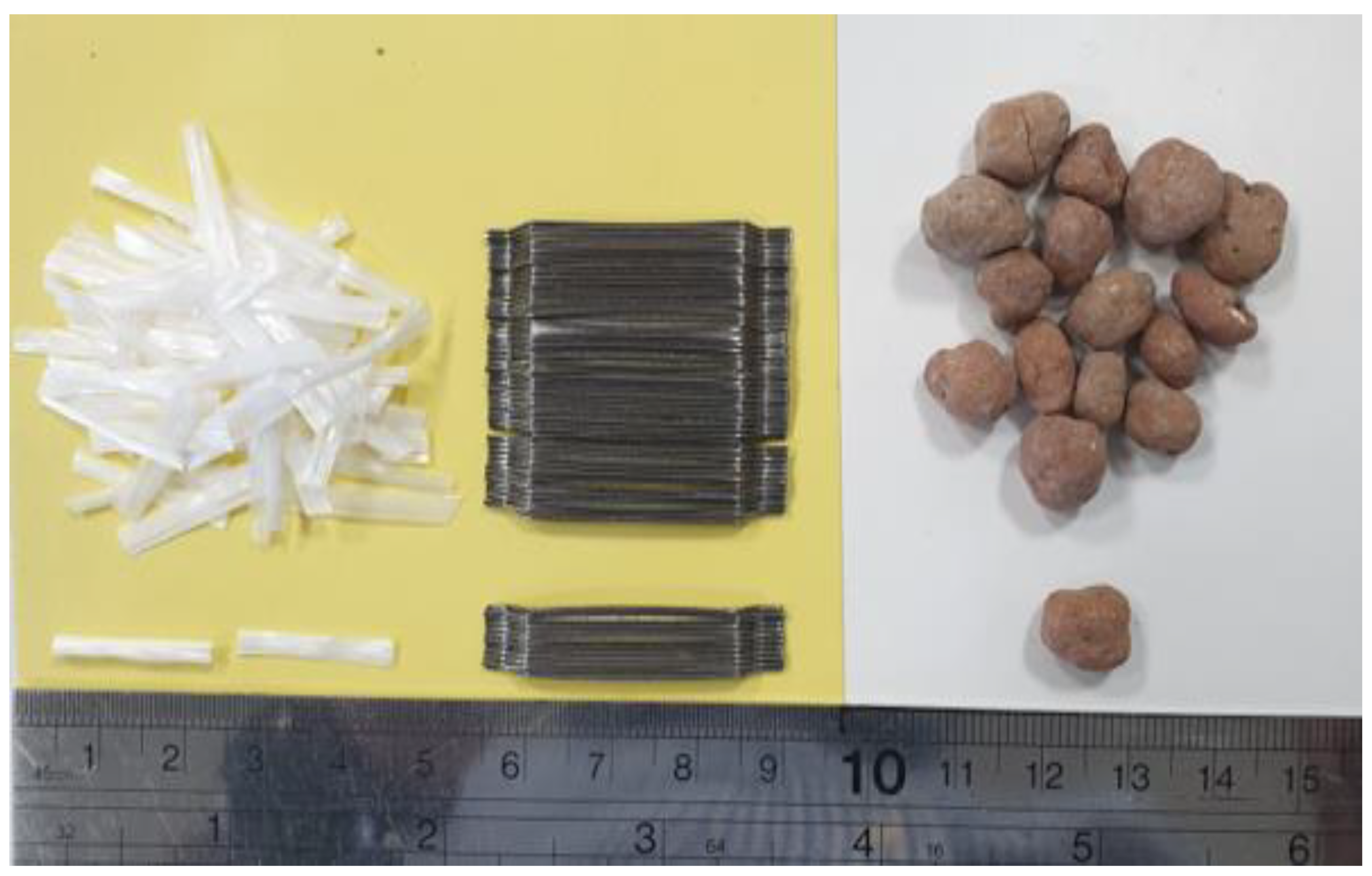
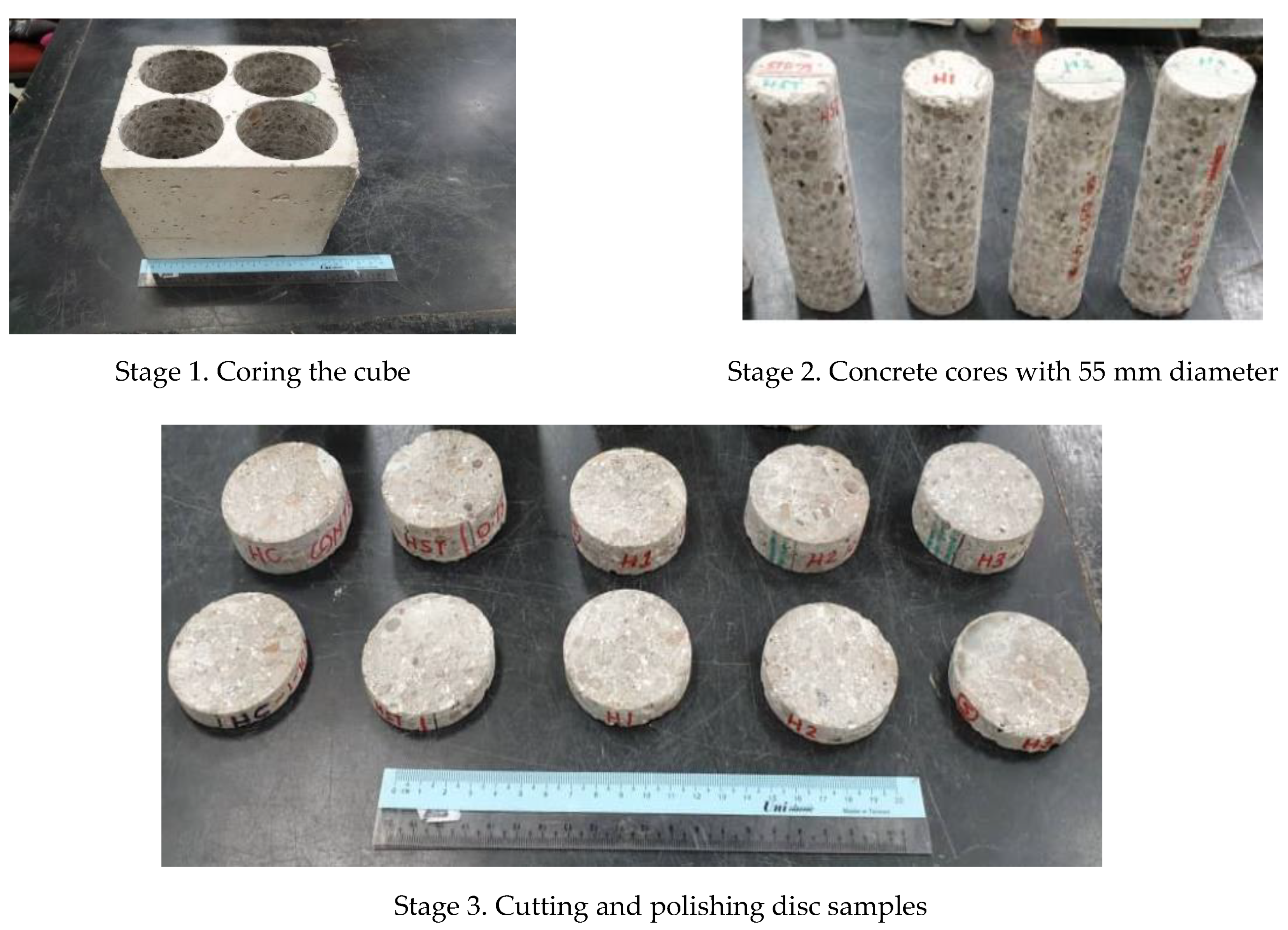

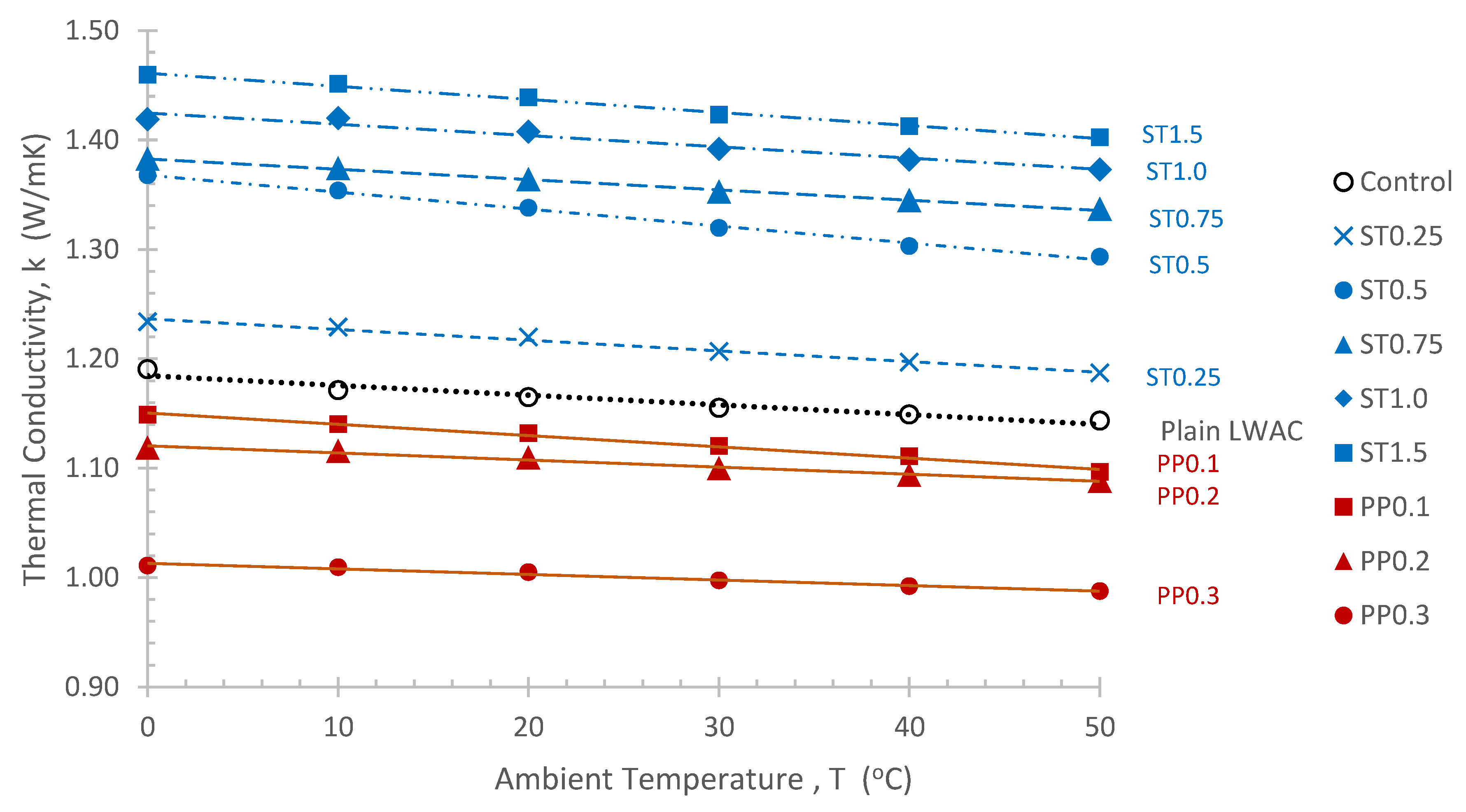
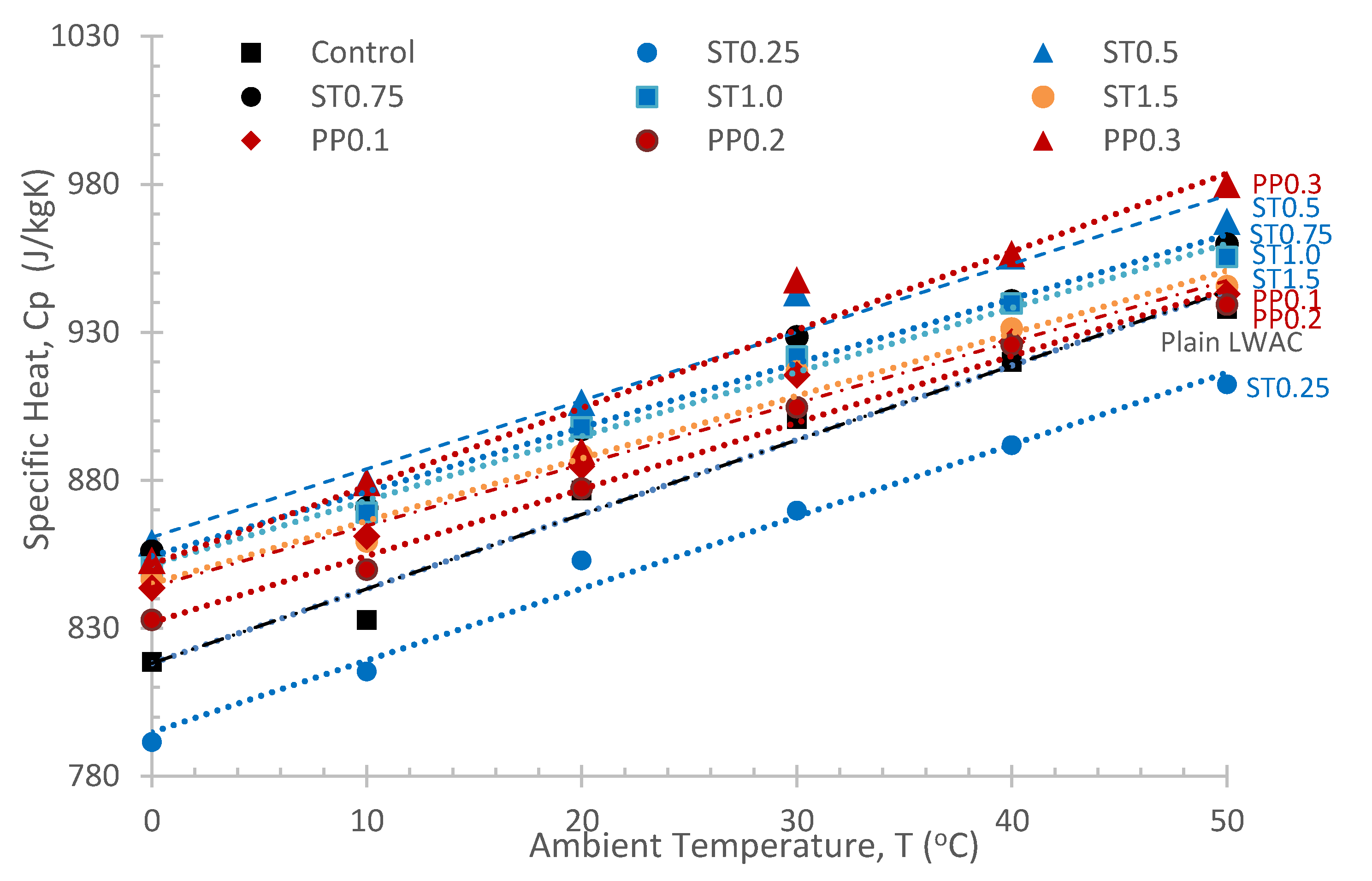
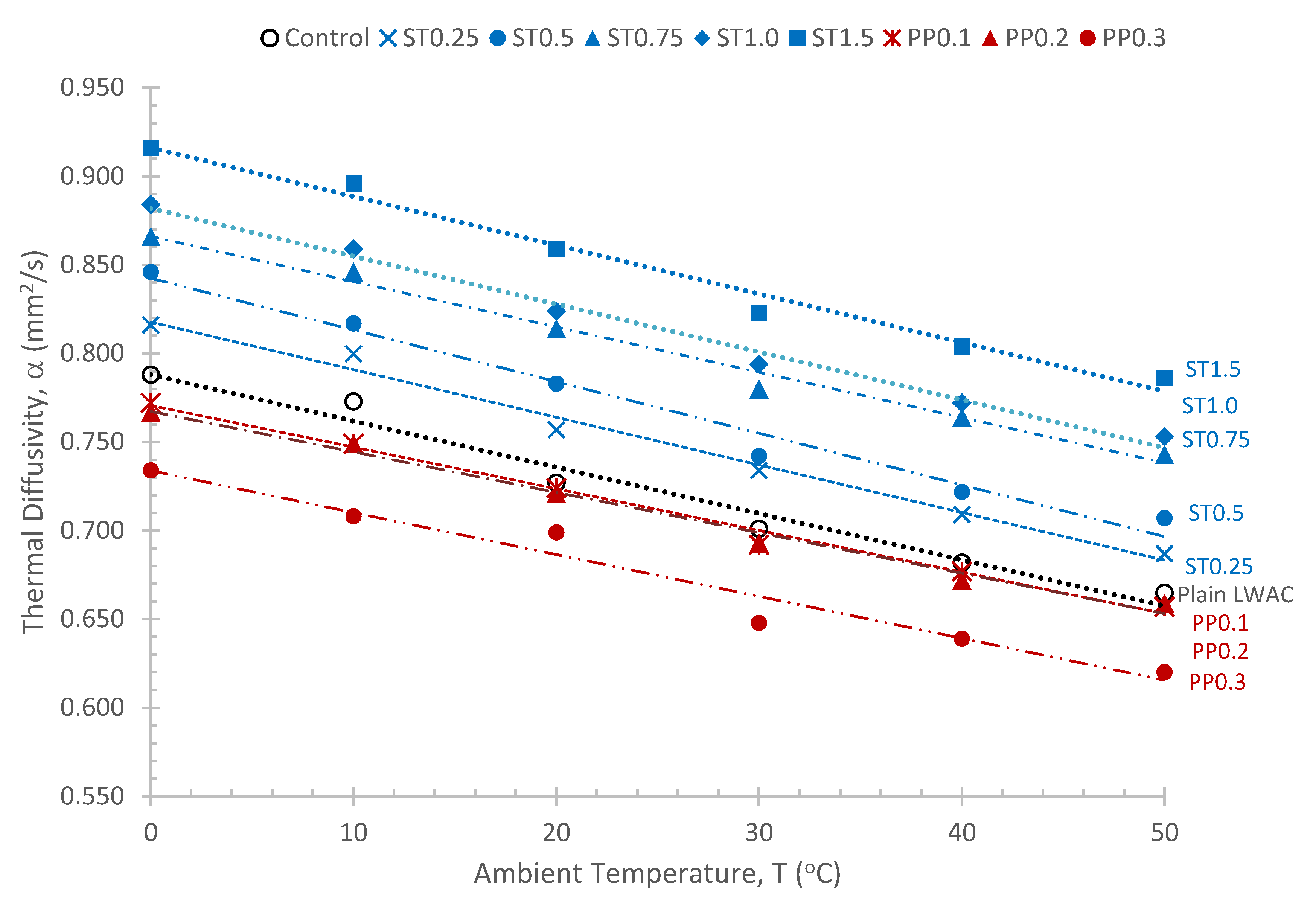
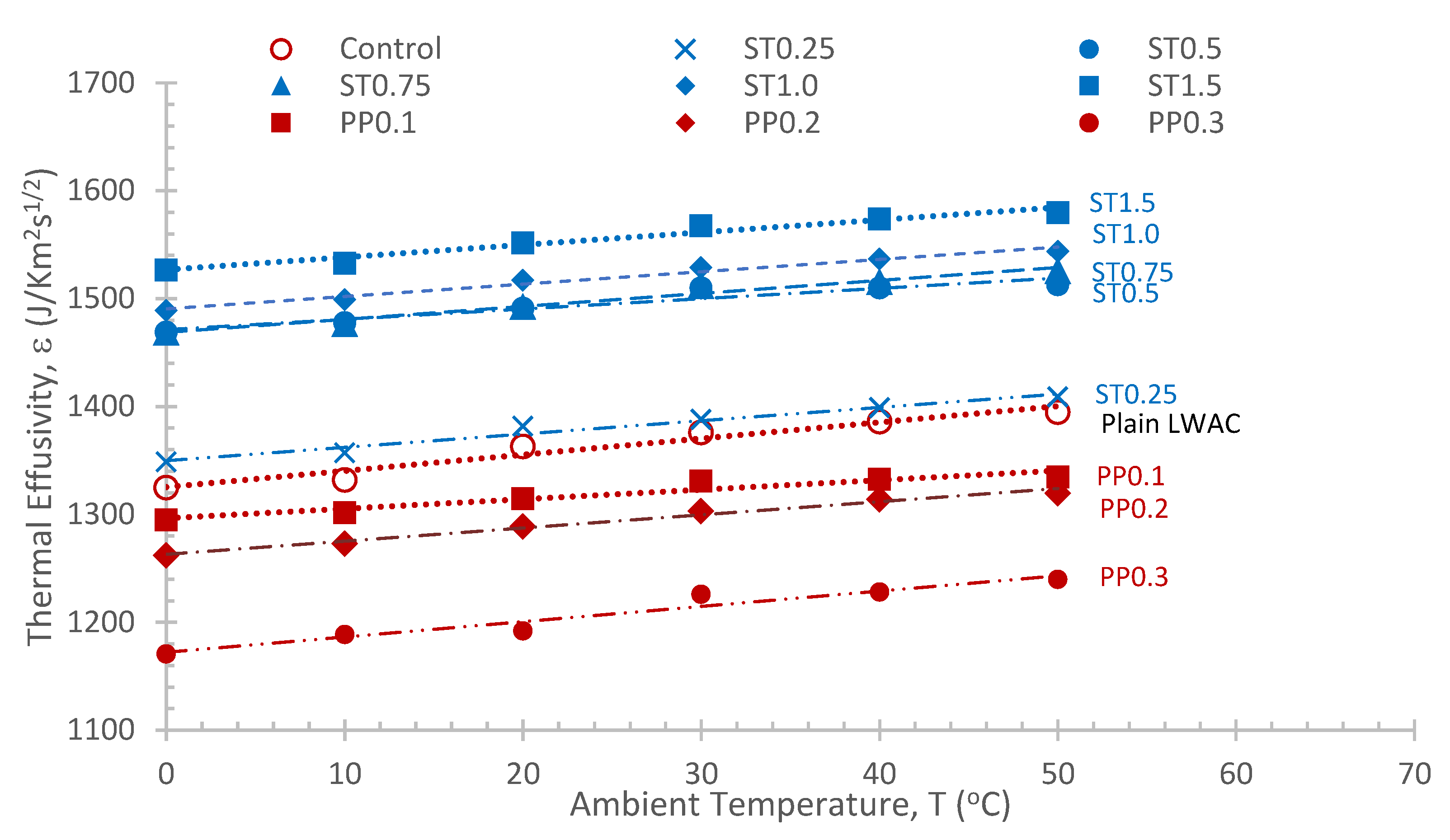
| CaO | SiO2 | Al2O3 | Fe2O3 | MgO | SO3 | K2O | Na2O | Lost on Ignition | |
|---|---|---|---|---|---|---|---|---|---|
| Cement | 63.40 | 19.80 | 5.10 | 3.10 | 2.50 | 2.40 | 1.00 | 0.19 | 1.80 |
| GGBFS | 49.76 | 29.35 | 11.72 | 0.52 | 4.20 | 2.09 | 0.46 | - | - |
| Chemical Composition of the LECA Aggregates (% by Mass) | ||||||||||
|---|---|---|---|---|---|---|---|---|---|---|
| CaO | SiO2 | Al2O3 | Fe2O3 | MgO | SO3 | K2O | Na2O | BaO | TiO2 | P2O5 |
| 3.57 | 53.50 | 24.47 | 8.98 | 1.42 | 0.07 | 4.08 | 2.24 | 0.10 | 0.96 | 0.0064 |
| Type of Fibres | Length, l (mm) | Diameter, d (mm) | Aspect Ratio (l/d) | Geometry | Solid Density (kg/m3) | Modulus GPa | Tensile Strength (MPa) | Failure Strain (%) |
|---|---|---|---|---|---|---|---|---|
| Steel (ST) | 35 | 0.54 | 65 | Hooked-end | 7840 | 210 | 1200 | 3.5 |
| Polypropylene (PP) | 19 | 0.016 | 1188 | Fibrillated | 900 | 3.9 | 400 | 15 |
| Mix Code | Cement (kg/m3) | GGBFS (kg/m3) | LECA (kg/m3) | Sand (kg/m3) | Water (kg/m3) | Water to Binder Ratio | VF 1 (%) | SP 2 (%) | Oven Dried Density (kg/m3) | Vebe (s) | Slump (mm) | 28-Day Compressive Strength (MPa) |
|---|---|---|---|---|---|---|---|---|---|---|---|---|
| Control | ||||||||||||
| Plain LWAC | 400 | 60 | 506 | 837 | 161 | 0.35 | 0 | 1 | 1831 | 4 | 70 | 47.1 |
| ST Fibre | ||||||||||||
| ST0.25 | 400 | 60 | 506 | 837 | 161 | 0.35 | 0.25 | 1 | 1847 | 6 | 55 | 50.2 |
| ST0.50 | 400 | 60 | 506 | 837 | 161 | 0.35 | 0.50 | 1 | 1865 | 6 | 55 | 51.2 |
| ST0.75 | 400 | 60 | 506 | 837 | 161 | 0.35 | 0.75 | 1 | 1909 | 7 | 45 | 53.4 |
| ST1.00 | 400 | 60 | 506 | 837 | 161 | 0.35 | 1.00 | 1 | 1934 | 11 | 15 | 54.1 |
| ST1.50 | 400 | 60 | 506 | 837 | 161 | 0.35 | 1.50 | 1 | 1951 | 16 | 5 | 47.4 |
| PP Fibre | ||||||||||||
| PP0.1 | 400 | 60 | 506 | 837 | 161 | 0.35 | 0.1 | 1 | 1776 | 4 | 70 | 46.3 |
| PP0.2 | 400 | 60 | 506 | 837 | 161 | 0.35 | 0.2 | 1 | 1759 | 5 | 65 | 48.9 |
| PP0.3 | 400 | 60 | 506 | 837 | 161 | 0.35 | 0.3 | 1 | 1688 | 8 | 40 | 44.9 |
| Thermal Conductivity, kW/mK | ||||||||||||
|---|---|---|---|---|---|---|---|---|---|---|---|---|
| Temperature | 0 °C | COV% 1 | 10 °C | COV% | 20 °C | COV% | 30 °C | COV% | 40 °C | COV% | 50 °C | COV% |
| Plain LWAC | 1.190 | 6.69 | 1.171 | 6.46 | 1.165 | 6.29 | 1.155 | 6.16 | 1.149 | 6.08 | 1.143 | 6.01 |
| ST0.25 | 1.233 | 6.63 | 1.229 | 6.51 | 1.220 | 6.40 | 1.207 | 6.29 | 1.197 | 6.12 | 1.187 | 5.94 |
| ST0.5 | 1.367 | 3.45 | 1.354 | 3.46 | 1.338 | 3.43 | 1.319 | 3.51 | 1.303 | 3.36 | 1.293 | 3.50 |
| ST0.75 | 1.383 | 3.06 | 1.374 | 2.88 | 1.364 | 2.90 | 1.353 | 2.87 | 1.345 | 2.92 | 1.337 | 3.00 |
| ST0.1 | 1.419 | 8.33 | 1.420 | 8.11 | 1.407 | 8.01 | 1.392 | 7.97 | 1.382 | 7.93 | 1.373 | 7.89 |
| ST1.5 | 1.459 | 5.33 | 1.451 | 5.57 | 1.439 | 5.59 | 1.423 | 5.54 | 1.412 | 5.54 | 1.402 | 5.52 |
| PP0.1 | 1.149 | 6.58 | 1.140 | 6.52 | 1.132 | 6.51 | 1.120 | 6.50 | 1.111 | 6.94 | 1.096 | 7.00 |
| PP0.2 | 1.118 | 12.22 | 1.116 | 12.28 | 1.109 | 12.15 | 1.100 | 12.10 | 1.094 | 11.94 | 1.088 | 11.79 |
| PP0.3 | 1.011 | 6.14 | 1.010 | 5.90 | 1.005 | 5.74 | 0.997 | 5.55 | 0.992 | 5.36 | 0.987 | 5.22 |
| Mix Code | Equation | R2 Value |
|---|---|---|
| Control | ||
| Plain LWAC | kPLWAC= −0.0009T + 1.1845 | 0.9455 |
| ST Fibre | ||
| ST0.25 | kST0.25 = −0.001T + 1.236 | 0.9865 |
| ST0.5 | kST0.5 = −0.0015T + 1.3678 | 0.9945 |
| ST0.75 | kST0.75 = −0.0009T + 1.3826 | 0.9967 |
| ST1.0 | kST1.0 = −0.001T + 1.4246 | 0.9573 |
| ST1.5 | kST1.5 = −0.0012T + 1.461 | 0.9935 |
| PP Fibre | ||
| PP0.1 | kPP0.1 = −0.001T + 1.1504 | 0.9919 |
| PP0.2 | kPP0.2 = −0.0006T + 1.1204 | 0.9825 |
| PP0.3 | kPP0. = −0.0005T + 1.013 | 0.9747 |
| Specific Heat, Cp (Joule/kgK) | ||||||||||||
|---|---|---|---|---|---|---|---|---|---|---|---|---|
| Temperature | 0 °C | COV% 1 | 10 °C | COV% | 20 °C | COV% | 30 °C | COV% | 40 °C | COV% | 50 °C | COV% |
| Plain LWAC | 819 | 6.56 | 833 | 8.63 | 877 | 5.30 | 901 | 5.61 | 920 | 5.05 | 938 | 5.14 |
| ST0.25 | 791 | 4.89 | 815 | 8.70 | 853 | 6.36 | 870 | 6.52 | 892 | 6.21 | 912 | 6.10 |
| ST0.5 | 859 | 1.93 | 880 | 2.06 | 906 | 2.23 | 943 | 2.72 | 956 | 2.09 | 967 | 1.97 |
| ST0.75 | 856 | 3.68 | 871 | 2.39 | 897 | 2.58 | 928 | 2.86 | 941 | 2.72 | 960 | 2.25 |
| ST1.0 | 851 | 3.85 | 869 | 4.25 | 898 | 4.38 | 922 | 5.72 | 940 | 4.31 | 955 | 4.35 |
| ST1.5 | 847 | 1.29 | 859 | 1.15 | 888 | 1.19 | 917 | 1.33 | 931 | 1.38 | 946 | 0.94 |
| PP0.1 | 843 | 5.75 | 861 | 5.06 | 885 | 4.06 | 915 | 4.77 | 927 | 4.34 | 943 | 3.91 |
| PP0.2 | 833 | 4.48 | 850 | 4.26 | 877 | 6.49 | 905 | 2.56 | 926 | 3.27 | 939 | 3.15 |
| PP0.3 | 853 | 6.14 | 879 | 5.90 | 890 | 5.74 | 947 | 5.55 | 956 | 5.36 | 980 | 5.22 |
| Mix Code | Equation | R2 Value |
|---|---|---|
| Control | ||
| Plain LWAC | CpControl= 2.5156T + 818.14 | 0.9765 |
| ST Fibre | ||
| ST0.25 | CpST0.25 = 2.2499T + 794.81 | 0.9870 |
| ST0.5 | CpST0.5 = 2.3091T + 860.74 | 0.9710 |
| ST0.75 | CpST0.75 = 2.1719T + 854.39 | 0.9854 |
| ST1.0 | CpST1.0 = 2.169T + 851.45 | 0.9908 |
| ST1.5 | CpST1.5 = 2.1121T + 845.13 | 0.9813 |
| PP Fibre | ||
| PP0.1 | CpPP0.1 = 2.0699T + 843.93 | 0.9837 |
| PP0.2 | CpPP0.2 = 2.2517T + 831.91 | 0.9901 |
| PP0.3 | CpPP0.3 = 2.6403T +851.58 | 0.9597 |
| Thermal Diffusivity, a (mm2/s) | ||||||||||||
|---|---|---|---|---|---|---|---|---|---|---|---|---|
| Temperature | 0 °C | COV% 1 | 10 °C | COV% | 20 °C | COV% | 30 °C | COV% | 40 °C | COV% | 50 °C | COV% |
| Plain LWAC | 0.788 | 8.04 | 0.773 | 10.78 | 0.727 | 7.61 | 0.701 | 7.92 | 0.682 | 7.23 | 0.665 | 7.11 |
| ST0.25 | 0.816 | 7.72 | 0.800 | 9.88 | 0.757 | 8.45 | 0.734 | 8.34 | 0.709 | 8.30 | 0.687 | 7.83 |
| ST0.5 | 0.846 | 3.55 | 0.817 | 3.37 | 0.783 | 3.15 | 0.742 | 4.97 | 0.722 | 3.04 | 0.707 | 3.09 |
| ST0.75 | 0.866 | 4.61 | 0.846 | 4.35 | 0.814 | 4.59 | 0.780 | 4.73 | 0.764 | 4.46 | 0.743 | 4.70 |
| ST0.1 | 0.884 | 8.63 | 0.859 | 8.75 | 0.824 | 8.63 | 0.794 | 8.99 | 0.772 | 8.47 | 0.753 | 8.34 |
| ST1.5 | 0.916 | 3.60 | 0.896 | 3.70 | 0.859 | 3.61 | 0.823 | 3.66 | 0.804 | 3.48 | 0.786 | 3.71 |
| PP0.1 | 0.772 | 5.64 | 0.749 | 5.62 | 0.724 | 6.25 | 0.692 | 6.06 | 0.677 | 6.18 | 0.657 | 6.23 |
| PP0.2 | 0.767 | 7.06 | 0.749 | 7.74 | 0.721 | 7.77 | 0.693 | 7.54 | 0.672 | 7.68 | 0.659 | 8.20 |
| PP0.3 | 0.734 | 9.59 | 0.708 | 5.68 | 0.699 | 9.61 | 0.648 | 5.60 | 0.639 | 5.21 | 0.620 | 5.33 |
| Mix Code | Equation | R2 Value |
|---|---|---|
| Control | ||
| Plain LWAC | a Control = −0.0026T + 0.788 | 0.9727 |
| ST Fibre | ||
| ST0.25 | aST0.25 = −0.0027T + 0.8177 | 0.9875 |
| ST0.5 | aST0.5 = −0.0029T + 0.8424 | 0.9791 |
| ST0.75 | aST0.75 = −0.0026T + 0.8661 | 0.9878 |
| ST1.0 | aST1.0 = −0.0027T + 0.8819 | 0.9903 |
| ST1.5 | aST1.5 = −0.0027T + 0.916 | 0.9828 |
| PP Fibre | ||
| PP0.1 | aPP0.1 = −0.0024T + 0.7706 | 0.9911 |
| PP0.2 | aPP0.2 = −0.0023T + 0.7672 | 0.9886 |
| PP0.3 | aPP0.3 = −0.0024T + 0.7338 | 0.9606 |
| Thermal Effusivity, e (J/Km2s1/2) | ||||||||||||
|---|---|---|---|---|---|---|---|---|---|---|---|---|
| Temperature | 0 °C | COV% 1 | 10 °C | COV% | 20 °C | COV% | 30 °C | COV% | 40 °C | COV% | 50 °C | COV% |
| Plain LWAC | 1325 | 4.05 | 1332 | 4.49 | 1363 | 4.13 | 1376 | 3.83 | 1386 | 3.91 | 1395 | 4.15 |
| ST0.25 | 1349 | 4.17 | 1357 | 5.30 | 1382 | 3.80 | 1388 | 3.99 | 1399 | 3.52 | 1409 | 3.71 |
| ST0.5 | 1469 | 2.20 | 1478 | 2.27 | 1491 | 2.34 | 1510 | 1.72 | 1510 | 2.23 | 1513 | 2.32 |
| ST0.75 | 1469 | 3.02 | 1477 | 2.17 | 1493 | 1.99 | 1512 | 2.23 | 1516 | 2.27 | 1526 | 1.85 |
| ST0.1 | 1489 | 5.63 | 1499 | 5.59 | 1517 | 5.58 | 1529 | 6.33 | 1537 | 5.61 | 1544 | 5.65 |
| ST1.5 | 1527 | 3.39 | 1533 | 3.31 | 1552 | 3.32 | 1568 | 3.33 | 1574 | 3.36 | 1580 | 3.20 |
| PP0.1 | 1295 | 4.35 | 1302 | 4.30 | 1315 | 4.00 | 1331 | 4.16 | 1333 | 4.32 | 1335 | 4.39 |
| PP0.2 | 1262 | 8.95 | 1273 | 8.60 | 1289 | 8.24 | 1303 | 8.41 | 1314 | 8.17 | 1320 | 7.78 |
| PP0.3 | 1171 | 2.74 | 1189 | 4.86 | 1192 | 4.42 | 1226 | 3.62 | 1228 | 4.08 | 1240 | 3.93 |
| Mix Code | Equation | R2 Value |
|---|---|---|
| Control | ||
| Plain LWAC | PLWAC= 1.5000T + 1325.3 | 0.9541 |
| ST Fibre | ||
| ST0.25 | ε ST0.25= 1.2343T + 1349.8 | 0.9669 |
| ST0.5 | ε ST0.5= 0.9571T + 1471.2 | 0.9136 |
| ST0.75 | ε ST0.75= 1.2029T + 1468.8 | 0.9713 |
| ST1.0 | εST1.0= 1.1457T + 1490.5 | 0.9763 |
| ST1.5 | ε ST1.5= 1.1543T + 1526.8 | 0.9598 |
| PP Fibre | ||
| PP0.1 | ε PP0.1= 0.8829T + 1296.4 | 0.9244 |
| PP0.2 | ε PP0.2= 1.22T + 1263 | 0.9846 |
| PP0.3 | ε PP0.3= 1.417T + 1172.2 | 0.9846 |
Publisher’s Note: MDPI stays neutral with regard to jurisdictional claims in published maps and institutional affiliations. |
© 2022 by the authors. Licensee MDPI, Basel, Switzerland. This article is an open access article distributed under the terms and conditions of the Creative Commons Attribution (CC BY) license (https://creativecommons.org/licenses/by/4.0/).
Share and Cite
Shafigh, P.; Hafez, M.A.; Che Muda, Z.; Beddu, S.; Zakaria, A.; Almkahal, Z. Influence of Different Ambient Temperatures on the Thermal Properties of Fiber-Reinforced Structural Lightweight Aggregate Concrete. Buildings 2022, 12, 771. https://doi.org/10.3390/buildings12060771
Shafigh P, Hafez MA, Che Muda Z, Beddu S, Zakaria A, Almkahal Z. Influence of Different Ambient Temperatures on the Thermal Properties of Fiber-Reinforced Structural Lightweight Aggregate Concrete. Buildings. 2022; 12(6):771. https://doi.org/10.3390/buildings12060771
Chicago/Turabian StyleShafigh, Payam, Mohamed Ahmed Hafez, Zakaria Che Muda, Salmia Beddu, As’ad Zakaria, and Zaher Almkahal. 2022. "Influence of Different Ambient Temperatures on the Thermal Properties of Fiber-Reinforced Structural Lightweight Aggregate Concrete" Buildings 12, no. 6: 771. https://doi.org/10.3390/buildings12060771
APA StyleShafigh, P., Hafez, M. A., Che Muda, Z., Beddu, S., Zakaria, A., & Almkahal, Z. (2022). Influence of Different Ambient Temperatures on the Thermal Properties of Fiber-Reinforced Structural Lightweight Aggregate Concrete. Buildings, 12(6), 771. https://doi.org/10.3390/buildings12060771







